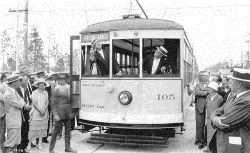A Special Moment In Time: The Time Of The Trolley – Coral Gables Part II
[AdSense-A]
Although almost all of the articles that have appeared in this column have dealt with a special moment in the passage of time in Greater Miami’s history it is possible that the era of the street and electric railways in Greater Miami—the time of the trolley—may, indeed, have been the most special time of all. Unhappily, hat moment in time—all 21 years of it—was terribly brief.
Miami’s electric trolleys did run for two years in the first ten years of the twentieth century but then disappeared until 1919, being replaced by both horse drawn and battery powered vehicles on rails but it was not until the end of World War I that the idea of regular, electrically powered, streetcar service took hold and a Miami line would extend out Flagler Street to then comparatively distant Northwest 22nd Avenue while the Southwest Second Avenue line went into the trolley barn at Southwest Second Street and Second Avenue.
With the passage of time and the coming of the great boom of the early 1920s, innumerable land developments sprang up throughout Greater Miami, one of them the brainchild of a former Massachusetts-ite, George E. Merrick, whose father arrived in Miami, depending on the source, in either 1896 or 1898. The senior Merrick had purchased property southwest of Miami and he named the rather humble abode on the property “Coral Gables” to commemorate the homesite, in Massachusetts, of the family’s beloved President, Grover Cleveland, who lived in “Grey Gables.”
After developing several modest Miami subdivisions, Merrick determined, with his wife, the former Eunice Peacock, that he would build what would be only the second planned city in America (Washington, D. C., with the L’enfant Plan, laid out in 1792, was the first) which he would call “Coral Gables.” Although Merrick laid out home sites, apartments, commercial and recreational areas, the fact was that the great draw remained the city of Miami, and even then Flagler Street was developing its world renowned cachet as a fine and elegant shopping district. Eventually, on Saturdays, the women, always wearing hats and white gloves, dined elegantly in the Burdine’s Hibiscus tea room.
Merrick realized that he needed a reliable and convenient method of transportation to bring people to Miami and back to Coral Gables and he wisely recognized that “the way to go” would be to build a street car line. His first line would leave the terminal at Coral Way (now Miracle Mile) and head north on Ponce de Leon, following the curve of that famous street and swinging onto Flagler Street, where, at Northwest 22nd Avenue it would meet the City of Miami Electric Railway tracks and proceed into downtown Miami using the connecting company’s trackage.
Unfortunately, what came to be “the local line” was also somewhat slow for those making the complete city to city trip and to remedy that situation, Mr. Merrick embarked on another of his great achievements: the building of a high speed interurban electric railway utilizing the median of Coral Way (where the huge banyans now reside) swinging north on that leg of Coral Way and then curving east on Southwest 13th Street the couple of blocks to Southwest Second Avenue, whence the interurbans would cross the Miami River and head north to Flagler, where they would turn east and proceed to loop around downtown Miami back to their connection to the Gables trackage.
There were several short and short-lived extensions but the one that was well ahead of its time was the Bird Road line which went west on Bird almost to 72nd Avenue. A paucity of riders would doom that line quite early but the two main lines soldiered on until the very late in the season November 4th, 1935 hurricane destroyed most of the system’s overhead and left several trolleys stranded out on the line. They were pulled in by trucks and the Coral Gables Rapid Transit Company, along with so many of the other great dreams of the 1920s, met its unhappy end in the middle of the worst Depression the United States had ever experienced.
The City, teetering on the verge of bankruptcy, and without anywhere near the funds necessary to repair the heavily damaged infrastructure, simply “threw in the towel,” and the Coral Gables trolleys became nothing more than a memory on November 5th, 1935. There are no real remnants of anything relating to that system anywhere in the Gables other than the now being used for electric light poles for a short distance on Sunset, but other than that, the bulk of the memorabilia—the photos, booklets, brochures and postcards, as well as several hat badges—has found a safe haven in and at The Bramson Archive, where that material, along with all of the other Miami memorabilia and Floridiana is safely preserved.
We will, in our next visit, continue with this story, but moving on to a different part of town. Please try to join us, won’t you?!!
[si-contact-form form=’2′]


